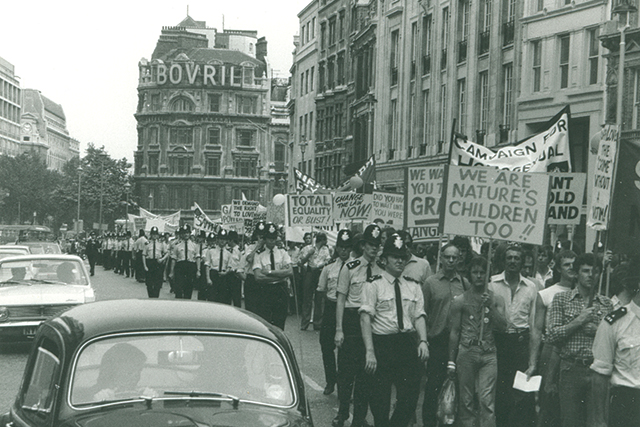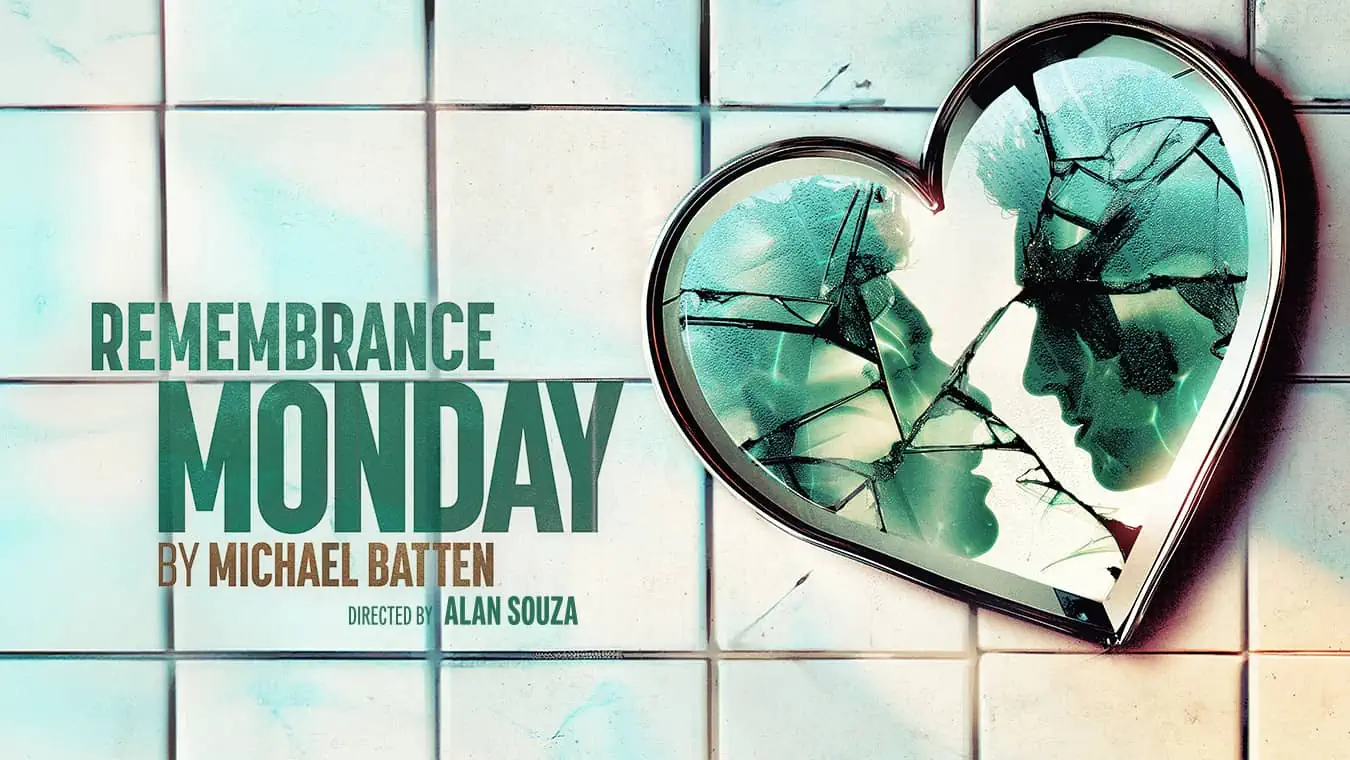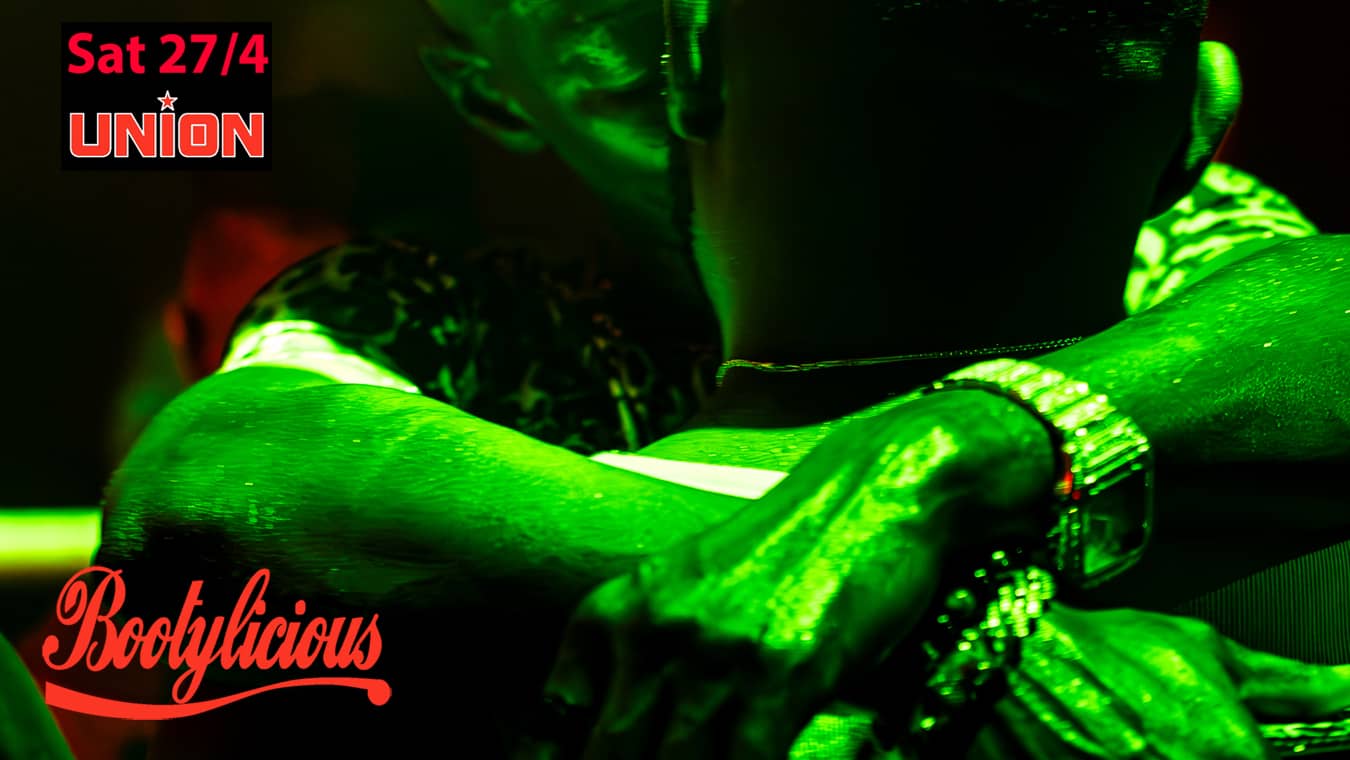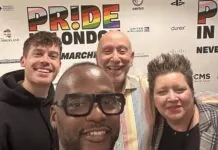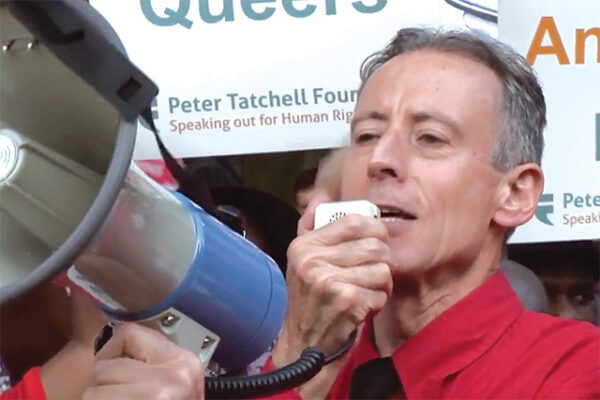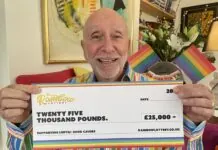On July 1st 1972, over 700 LGBT demonstrators made history by marching through London for the first official Pride carnival. It was the largest public display of its kind to date, but it certainly wasn’t the first. Chris Godfrey spoke with the radical drag queens who took to the streets of London just days before, in a daring display of defiance and decadence.
In 1970, homosexuality was still criminalised in Scotland and Northern Ireland, public displays of same-sex relationships remained illegal, the age of consent for gay men stood at 21 and the Gay Liberation Front (GLF) had formed, releasing it’s manifesto later that year.

“I’d ran away from school – well, I was thrown out for being a corrupting influence on the younger pupils,” says Hows. “I was living in a gay squat in Notting Hill Gate with 15 other gay men, sharing all possessions and all money and taking LSD every Saturday night.”
Among the groups other preferred activities was a form of subversive, genderfuck drag. It was a hobby they very much enjoyed sharing with the general public, whether that involved joining demonstrations, patrolling trains and offering bewildered passengers refreshments and conversation, or taking tea trolleys up to Hampstead Heath and educating cottagers about gay liberation.
“We were so well known in the area for our politics and we lifted a pedestrian demonstration…up that couple of notches,” says Michael James, another member of the radical drag queens who squatted in the same old film studio on Colville Terrace. James was inspired to join the GLF after a particularly traumatising police arrest near Green Park Station one night, as he looked for his lover at the time. Looking for any excuse, the police fabricated a scenario that allowed them to charge him for ‘importuning for an immoral purpose’. Joining the GLF allowed him to reclaim a sense of empowerment.
But when James and the other radical drag queens left their commune one weekday afternoon it was to protest a very different source of injustice. At a time when the Vietnam War had intensified, along with public anger towards it, the radical drag queens opted to spend the morning picketing outside the US embassy at Grosvenor Square, alongside the boilermakers union.
“We were offered to join the America Out of Vietnam demonstration,” says James. “So on the appointed day it was nails done, eye lashes on, whatever make up on and whatever frock we decided to wear. It was appropriate for the occasion. We didn’t usually wear evening gowns to serious political demonstrations, we wore nice smart dresses.”
“A man wearing a dress in the street is potent. It’s very strong. And people were very afraid of it.”
Donning a trilby hat, a black cape, a 1930s wrap over the shoulders and a pair of multi-coloured wedge heeled shoes, James joined the group of around 15 or so drag activists who had assembled themselves to the side of the steps on Grosvenor Square, opposite the band of boilermakers. After a few hours picketing, the queens noticed a nearby crowd of workers on their lunch, listening to an orchestra on Grosvenor Square. Drawn in by the forties dance music, the queens swanned over.

The onlookers may have assumed the drag queens were part of the show, but the frosty faced conductor knew otherwise. Angry at the spectacle and determined to protect the innocence of his orchestra he packed away his conductor’s baton and stopped the music. The queens, in no mood to go home, decided to take a trip to the Meat Rack, a notorious hangout for escorts.
“It was probably Julian who said ‘oh let’s go down on to the Piccadilly Circus and chat to the rent boys’,” says James. “So off we trotted, walking down…on to the Circus.” As well as spending time talking to the many boys that came up to them and drawing in a crowd of working escorts, the queens decided to patrol the inner sanctum of the Meat Market, banging on the stalls, screaming “closet queens come out”. Many of them did and, dressed in their masculine disguise of suits and shirt, fled. Somewhat inevitably, the scene drew the attention of the Metropolitan police.
“Of course the cry went up: ‘Lilly Law – scarper’,” says James. The police proceeded to chase the queens through the warrens of Piccadilly Circus, many of who had bolted for the exit leading out onto lower Regent Street. Despite wearing high heels, they kept 50 yards ahead of their pursuers and made for the Institute of Contemporary Arts, seeking sanctuary.
“At the ICA they happened to have an exhibition of revolutionary posters,” says James. “And of course, the true revolutionaries swept in through the door.” Staff at the ICA found the whole thing amusing. Rather than turf them out to the police, they instead offered them coffee and cake and showed them round their exhibition on revolutionaries, containing everything from Chairman Mao posters to Russian propaganda.

The coalition of radical drag queen activists, theatre queens and escorts had once again, unsurprisingly, attracted the interest of the local constabulary. This time though the police weren’t going to let them out of their sight. To them this debauch display was a protest, one that needed policing. What started out as a jovial stroll to check out the cottages was then rapidly transformed into a very potent political demonstration.
“We didn’t have a permit, let’s put it that way,” says Julian Hows. “We thought ok, let’s plan out and see how long the Saturday’s Pride march is going to take us. But suddenly they thought that this was a side event. Then quite a lot of people joined us; the usual hoi polloi and detritus of people who hung around Soho in the early seventies. There were far more people out in the street back then and we weren’t all segregated into the neat little ghetto around old Compton street.”
Eventually the group settled on marching towards Hyde Park, conducting a rather elaborate dress rehearsal of the GLF-organised Pride carnival to take place days later. As they marched through the streets, waving at onlookers and generally making a bit of a ruckus, half a dozen police lagged 15 yards behind.
“The police delivered us like a parcel and then rode off,” says Bette Bourne, who went on from the GLF to create his own seminal theatre troupe, the Bloolips. “I remember that very well. All the pleasure I remember. We were rolling about on the grass, kissing each other. It was my first kiss-in. I was with Tim Bolingbroke, one of the great kissers of the seventies.”
The day’s demonstration may have been seen by some LGBT people as a defiant and brave display at a time when they could’ve been arrested, but for Gay News, the first LGBT newspaper of its kind, it was just simply depraved.
“After we’d done our queens demonstration we went to the office of Gay News in Paddington,” says Stuart Feather. “We felt this is really important you know, they must know what we’ve been up to. This is real news. And we went in there and it was just a flop because they hated us.
“They had about four pages of hysterics about our behaviour and everything. It was the second edition of the paper and boy I don’t know what stories they had for the second edition but they binned them all and poured shit on us. They were there to save the rest of the country from gay liberation. That was really their stance. What they were really saving the nation from was drag queens like us. Completely assimilationist.”
“The coalition of radical drag activists, theatre queens and escorts had once again, unsurprisingly, attracted the interest of the local constabulary.”
Gay News weren’t the only publication appalled by their actions that week. The build up to the official Pride march that week had seen the radical drag queens engage in numerous demonstrations and public displays, so much so that even the mainstream media took an interest.
“The Sunday Times called them Fascists in Frocks,” says Lisa Power, author of No Bath But Plenty of Bubbles: Stories from the London Gay Liberation Front. “But they were quite a strong political faction within GLF. They called what they did radical drag, but the people who didn’t like them eventually called them the Rad Fems. That’s what they got condemned as.”
To the assimilationists within GLF, the ‘rad fems’ – resplendent in their genderfuck drag – were going about gay emancipation all wrong. Their messages of anarchic freedom, total liberation, of shunning male privilege and subverting gender were completely lost on those who sought to change the landscape for LGBT people through emphasising similarity, rather than difference.
“Well we were the drag queens in GLF and we caused an awful lot of trouble with the left, because they just had no ideology to cope with it,” says Stuart Feather. “They were outraged that we should be questioning their left wing authority, is really what it was about.”
“We had really pro-feminist politics,” he continues. “And it was the women in GLF, the lesbians, who had the really difficult time. Because a lot of the men, what we term the straight gays, they wouldn’t question their misogyny, their male pride, or their sexism. I think because they saw the prejudices coming from outside, they couldn’t accept that they were oppressing themselves.”
On 1st July, just days after their irreverent display of genderfuck drag through the streets of London, the GLF’s first official Pride march was held. As planned, the carnival-style parade followed the same route the radical queens had marched and attracted over 700 demonstrators, swamped by a heavy police presence. A success though it was, it wasn’t enough to stop the GLF from falling apart and breaking up into smaller factions.
“In terms of the group it just dispersed,” says Power. “I mean, really GLF was falling a part by the middle of the ‘72 and fell apart completely by ‘73. People became much more involved in the local groups and so on. GLF was effectively an explosion more than a movement. But what it did was set the pace for the importance of coming out, the importance of personal witness, the importance for gay activists wearing badges and being really upfront about the fact that you are gay. The influence of the GLF in the UK was massively beyond its size. Or its longevity.”
As for the radical drag queens, the group slowly dispersed in the coming years, though many still remain in touch with each other today. Bette Bourne went on to create his own theatre troupe, the Bloolips. While he feels the group’s power came from the fear they inspired in people, for him it was as much about the enjoying the drag as it was making a political statement.
“They comforted themselves by thinking it was trivial, because we were in dresses,” he says, recollecting the attitudes of other GLF members. “The problem was that we were so potent. A man wearing a dress in the street is potent. It’s very strong. And people were very afraid of it.
“A lot of the queens were very afraid of us because we were disobeying the rules in some deep way and scaring them. They were scared. People got very frightened. We weren’t frightened at all. But it was much stronger than anything they were doing. It was also about a sense of humour or not. Wearing the dresses was great fun as well. It certainly was for me.”
We meet the drag queen reading group that were victims of The Sun’s poisonous anti-trans campaign
Peppermint on coming out as trans, female drag queens & more…

